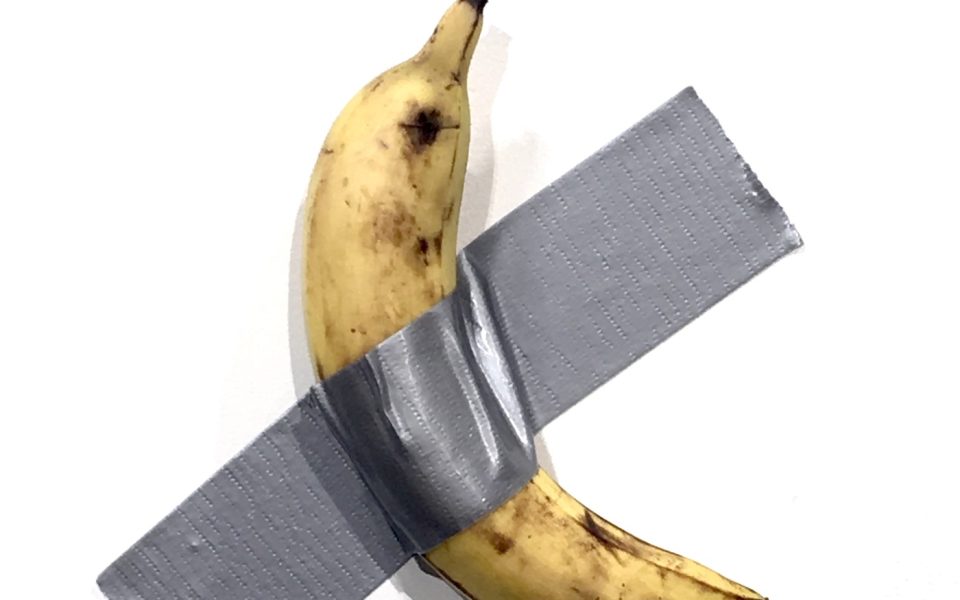Precious. Prank. Delicious.
These are the words used to describe the piece of art that’s
taken not only the art world, but broader society as well by storm.
“Comedian” by Italian artist Maurizio Cattelan was unveiled
at Art Basel in Miami last week during the annual premier international art
show.
Created in a set of threes, the piece has been steeped in
controversy ever since it first graced the festival’s stark-white walls. It’s
challenging to some, infuriating to others and simply confusing for most of us.
Oh, and it’s a banana duct taped to a wall. And the versions have sold for $120,000
to $150,000 each.
Upon first booking our flights to Miami for last week, my
fiancé and I didn’t initially even realize that the art show was going on at
the same time. But after finding out that the annual to-do would be happening,
we thought, Why not? So, we picked up tickets for a reasonable 60 bucks
each. Housed mostly in Miami Beach’s convention center, the show spans five
days and presents work from more than 200 galleries from across the world.
Close to 80,000 attendees visit each year.
As soon as we stepped into the building, it was immediately
clear to me and my fiancé, that we were out of place at the show. Despite it’s
rather-affordable tickets, it seemed like everyone in the space came decked out
in brand-name get-ups and designer sneakers while we wore crop tops and jeans
and short sleeves and slacks. We even ran into Serena Williams, who shopped the
market with her daughter and an assistant. (I freaked out and called almost
everyone I knew immediately.)
So it’s not surprising that a simple banana — not a
sculpture of a banana or even a photograph of one, but an actual banana
— adhered to a wall with a sideways strip of duct tape sold for more than
$100,000.
At first glance, it’s consumerism and hedonism at its
finest.
During my time as an art history student, I was often
confronted with the age-old question: What is art?
And that’s exactly the question everyone around the world
has been asking themselves since the controversial fruit made headlines a few
days ago.
Let’s start with Cattelan’s background as an artist.
Emerging into prominence in the late 1980s and ’90s,
Cattelan made wooden furniture in Italy. From there, he transitioned to
creating satirical sculptures like “LOVE,”a statue of a large middle
finger cut from marble; “La Nona Ora (The Ninth Hour),”which depicts a sculpture
of Pope John Paul II being hit by a meteorite; and his most famous work until
“Comedian,” “America,” an 18-karat solid gold toilet which was offered on loan
to President Trump after the Guggenheim declined his initial request for a
painting by Van Gogh.
-

“La Nona Ora” by Cattelan (photo by Fred Romero) -

The statue is named L.O.V.E., but many people refer to it by ‘Il Dito’ (the finger). It was erected in 2010 in front of Milan’s Stock Exchange building, in the centre of the North-Italian city.
So based on his past work, it’s not the like the man can’t
create what people consider art. And yet, this new “sculpture” if you want to
call it that, seems lazy, shallow and self-indulgent.
But maybe there’s something else here.
Maybe it’s meant to be a commentary on the absurdity of art and the art market and the way we value things as a society. Maybe, because it’s degradable, it speaks to our own mortality. And maybe it’s just a banana taped to a wall.
But isn’t that kind of the point of art? To challenge, to make one think, to spark conversation? And then, if you add the fact that a self-promoting “performance artist” came up a day later and ate the banana right off the wall, that adds another layer to the story and to the piece itself. While Cattelan hasn’t commented on the “vandalism,” any buyers of the pieces were instructed to replace the banana every week or so because of its impermanent nature.
So, is it art?
To answer this, I look to art critic Arthur Danto.
“The status of an artifact as work of art results from the
ideas a culture applies to it, rather than its inherent physical or perceptible
qualities,” he states. “Cultural interpretation (an art theory of some kind) is
therefore constitutive of an object’s arthood.”
In a sense, because of how much attention and thought we’ve
put into this banana on a wall, that’s what makes it art — it’s our own fault.
Join the First Amendment Society, a membership that goes directly to funding TCB‘s newsroom.
We believe that reporting can save the world.
The TCB First Amendment Society recognizes the vital role of a free, unfettered press with a bundling of local experiences designed to build community, and unique engagements with our newsroom that will help you understand, and shape, local journalism’s critical role in uplifting the people in our cities.
All revenue goes directly into the newsroom as reporters’ salaries and freelance commissions.


Leave a Reply